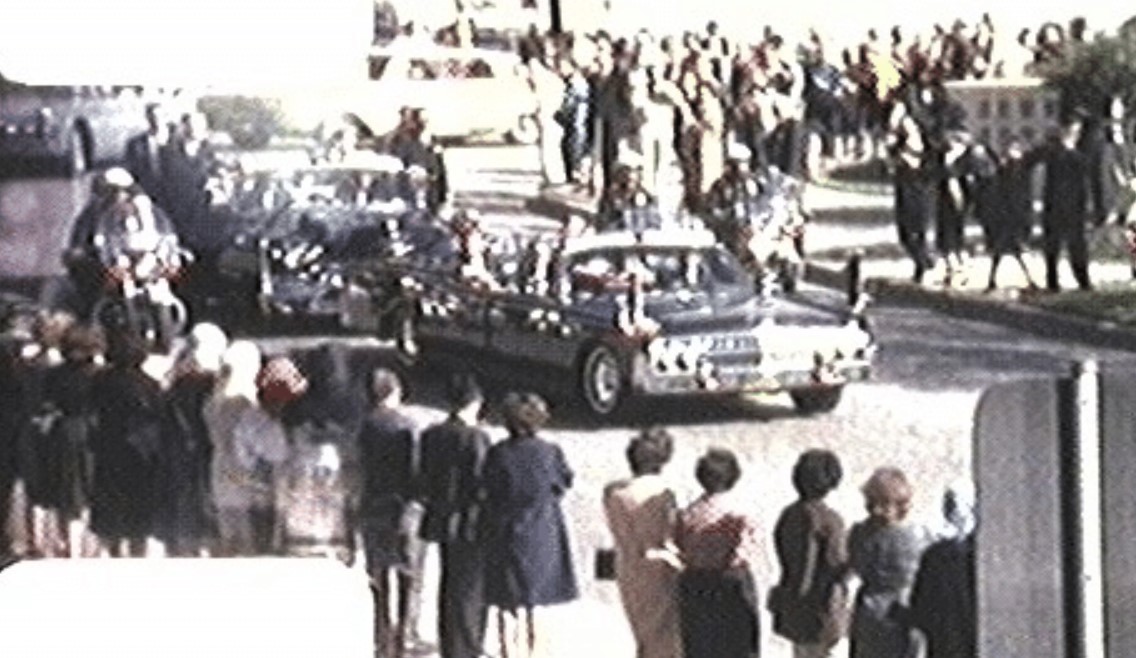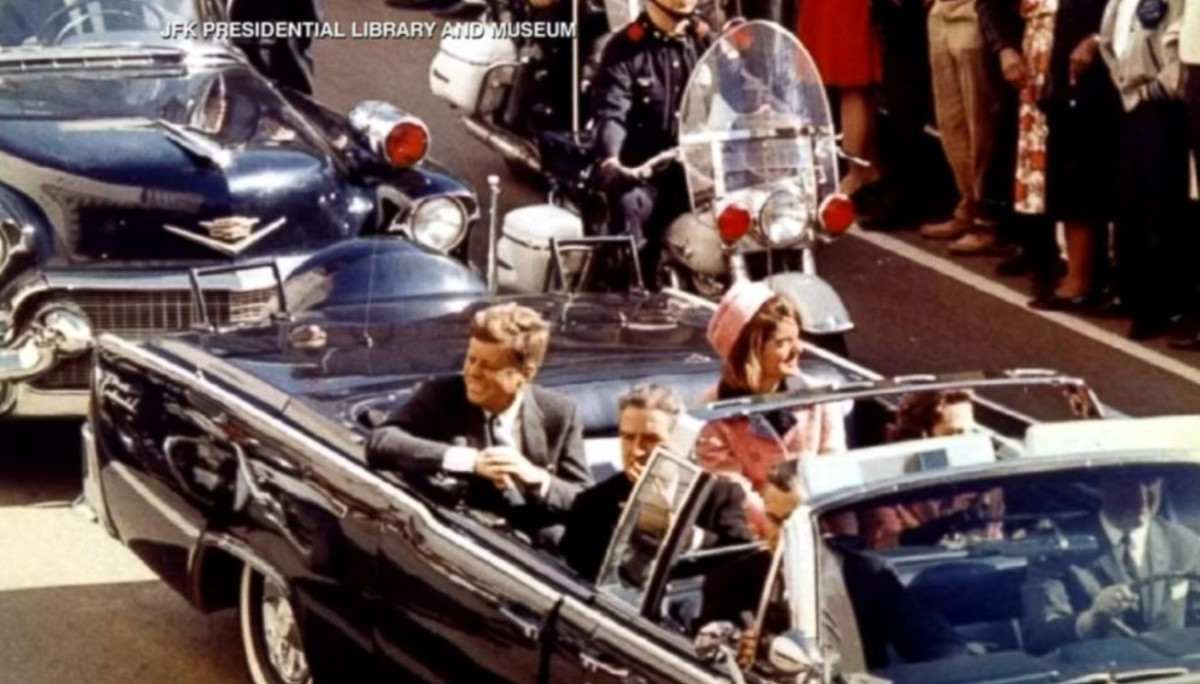JFK Assassination Video and Offering Fresh Insights
Recently discovered film footage capturing President John F. Kennedy’s motorcade rushing toward the hospital after he was fatally shot has surfaced. This 8mm home film, taken by Dale Carpenter Sr., provides a rare and vivid perspective of the immediate aftermath of the assassination, showing the frantic response as the motorcade sped down Interstate 35 toward Parkland Memorial Hospital.

The footage is particularly significant because it offers a fresh visual account of the chaos that unfolded after the shots were fired at Dealey Plaza. It captures Secret Service Agent Clint Hill in a dramatic moment as he clings to the back of the presidential limousine, protecting First Lady Jacqueline Kennedy. Experts say such discoveries are not entirely surprising, as historical materials related to the JFK assassination continue to be found in private collections and archives.
The newly surfaced footage is set to go up for auction at RR Auction in Boston on September 28. While the auction house has released still images from the film, they have opted not to make the full footage publicly available before the sale. This decision has further heightened interest among historians, collectors, and filmmakers eager to analyze its contents.
More than 60 years after JFK’s tragic assassination, new evidence and previously unseen materials continue to emerge, adding fresh insights into one of the most scrutinized events in American history. The upcoming auction will not only offer a rare piece of history to the highest bidder but may also contribute to ongoing research and documentary projects about that fateful day in 1963.
Contents
The Discovery and Video
A newly uncovered 8mm home film capturing the moments following President John F. Kennedy’s assassination has emerged, providing a rare perspective on one of the most tragic events in American history. The footage shows the presidential motorcade racing down Interstate 35 toward Parkland Memorial Hospital after JFK was shot in Dealey Plaza on November 22, 1963.
Video captures the crime scene
One of the most striking aspects of the footage is the clear depiction of Secret Service Agent Clint Hill, who had leaped onto the back of the presidential limousine in an effort to protect First Lady Jacqueline Kennedy. The color film, which lasts about 10 seconds, captures the urgency and high speed approximately 80 mph of the motorcade as it rushed to the hospital. Experts describe the footage as remarkable, as it vividly conveys the chaos and intensity of the moment.
The footage was originally filmed by Dale Carpenter Sr., who happened to be in the area and began recording the motorcade. However, it remained largely unknown for decades until his grandson, James Gates, discovered it. The film was stored in a milk crate among other family recordings, and when Gates inherited the collection, he was initially unaware of its significance. Around 2010, upon projecting the film onto his bedroom wall, he realized its historical value especially the dramatic moments showing Agent Hill’s precarious position on the limousine.
Now, over 60 years later, the film is set to be auctioned by RR Auction in Boston on September 28. The auction house has released still images but has not made the full footage publicly available, increasing anticipation among historians, collectors, and researchers.
The Context of JFK’s Assassination
The assassination of President John F. Kennedy remains one of the most analyzed events in U.S. history. On November 22, 1963, Kennedy was traveling through downtown Dallas in a motorcade when shots rang out as his car passed through Dealey Plaza.

Investigations later determined that the assassin, Lee Harvey Oswald, had positioned himself on the sixth floor of the Texas School Book Depository. He fired three shots at the president, two of which struck Kennedy, fatally wounding him. The moment of impact was famously captured on film by Abraham Zapruder, whose 26-second recording became one of the most studied pieces of evidence related to the assassination.
Immediately after the shooting, the presidential motorcade changed course, heading at high speed to Parkland Memorial Hospital. The newly discovered footage captures this desperate race, adding a new visual element to the timeline of events. Secret Service Agent Clint Hill, who had rushed to the limousine upon hearing gunfire, can be seen in the footage hovering protectively over Jacqueline Kennedy. Hill later described his immediate fear that more shots would be fired as he positioned himself to shield the First Lady.
Upon arrival at Parkland, Hill placed a phone call to Attorney General Robert Kennedy. In an emotional exchange, Robert Kennedy asked how bad the situation was. Not wanting to deliver the devastating news outright, Hill simply responded, “It’s as bad as it can get.” Moments later, JFK was pronounced dead at the hospital.
Significance of the Footage
Despite the wealth of existing material on JFK’s assassination, newly discovered footage continues to offer valuable insights. Experts note that such historical artifacts are often stored away in private collections, garages, or attics, only to resurface decades later.
Stephen Fagin, curator at The Sixth Floor Museum at Dealey Plaza, explains that materials related to the assassination are still being uncovered. The emergence of Carpenter’s film aligns with previous discoveries, such as the 2002 revelation of Jay Skaggs’ photographs, which included rare color images of the rifle being removed from the Texas School Book Depository.

The newly found footage provides a more complete view of the rush to Parkland Hospital. Previous film records have been fragmented, but this footage captures an extended segment of the motorcade’s journey at full speed. Farris Rookstool III, a historian and former FBI analyst, emphasizes that such discoveries help historians and filmmakers piece together a more detailed and accurate narrative of the event.
With the upcoming auction, many hope the footage will be acquired by an institution or researcher dedicated to preserving and studying JFK-related materials. More than 60 years after the assassination, the search for additional evidence and new perspectives on that fateful day continues, proving that history is still being uncovered, one frame at a time.
The Auction and Future of the Footage
The newly discovered footage of JFK’s motorcade racing toward Parkland Memorial Hospital is set to be auctioned by RR Auction in Boston on September 28. This rare 8mm film, captured by Dale Carpenter Sr., has drawn significant attention from historians, collectors, and documentary filmmakers eager to analyze its contents.
Despite the historical significance of the footage, the auction house has decided not to release the full film to the public before the sale. Instead, only still images have been made available, heightening anticipation about what the footage fully reveals. According to Bobby Livingston, executive vice president of RR Auction, the footage is remarkable not just for its clarity and color but also for the intensity it captures as the motorcade speeds down Interstate 35 at nearly 80 mph.
Experts hope that the footage will find a home where it can be properly preserved and analyzed. Some believe it could contribute to new documentary projects or research efforts aimed at providing a more complete view of the events following the assassination. The possibility that the film could end up in a private collection, rather than a public archive, raises concerns among historians who want to ensure that important historical records remain accessible for study.
This auction reflects the continued demand for JFK-related artifacts, as people remain fascinated by the assassination and its many unanswered questions. The eventual owner of the footage will play a key role in determining whether it becomes widely accessible or remains privately held.
The Ongoing Quest for JFK Assassination Evidence
More than six decades after JFK’s assassination, new materials related to the event continue to surface. Historians emphasize that such discoveries are not entirely surprising, as personal archives, attics, and forgotten storage spaces still hold undiscovered footage, photographs, and documents.
Stephen Fagin, curator at The Sixth Floor Museum at Dealey Plaza, has noted that many items linked to the assassination were instinctively kept by those who witnessed or documented the event. Over the years, these materials have occasionally resurfaced, offering new insights into one of history’s most closely analyzed crimes.
A notable example of such a discovery occurred in 2002 when Jay Skaggs walked into The Sixth Floor Museum carrying a shoebox. Inside were 20 photographs taken in Dealey Plaza before and after the assassination. Among these images were the only known color photographs of the rifle being removed from the Texas School Book Depository. For decades, historians had speculated about the identity of a photographer seen in earlier images. Skaggs’ revelation not only solved this mystery but also contributed valuable new evidence to the historical record.
In addition to privately held materials, government records related to the JFK assassination continue to be released. In December 2022, the National Archives and Records Administration declassified 13,173 documents, following an executive order by President Biden. While this was a significant release, thousands of sensitive records remain classified, fueling speculation about what they might contain. Some experts argue that these redacted documents could hold information implicating intelligence agencies or revealing undisclosed aspects of the investigation.
The continued emergence of both private and government-held materials suggests that our understanding of the assassination is still evolving. Each new discovery adds another layer to the historical narrative, reinforcing the need for careful preservation and analysis of all related artifacts.
The fascination with JFK’s assassination has endured for over 60 years, and the emergence of new evidence whether in the form of personal film footage, photographs, or government documents continues to captivate historians and the public alike. The newly discovered film of the motorcade’s frantic rush to the hospital offers yet another piece of the puzzle, adding to the wealth of visual records that document the events of November 22, 1963.
The impact of such discoveries extends beyond mere historical curiosity. Every new piece of footage or document has the potential to refine our understanding of what happened that day, providing additional context and perspectives that were previously unknown. For historians, preserving and analyzing these materials is crucial to ensuring that the most accurate and complete version of history is passed down to future generations.
As this latest film heads to auction, many hope it will be acquired by an institution or filmmaker dedicated to making it available for public study. Regardless of where it ends up, its discovery serves as a reminder that history is never truly settled there are always new details waiting to be uncovered, helping to shed light on the mysteries of the past.
Hot News -Johnny Manziel Bathtub Video with Josie Canseco
Ricardo López Video and The Shocking Diary of Björk Stalker
Denise Frazier Dog Video and Legal Implications
Georgia Harrison Video Scandal and Truth Behind
Sean Herman Video and Former Nashville Officer Arrested
Drake Video Leak and Its Impact on His Career
Kodak Black Viral Video and Kanye West Mentorship Offer

